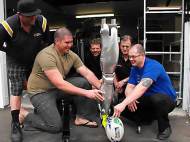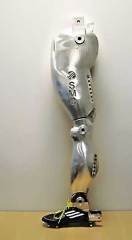Robotic leg to compete with humans in rugby ball kicking at Rugby World Cup
 A group of engineers from the Massey University developed a robotic leg on task to out-kick former All Black Andrew Mehrtens as part of an innovation showcase during Rugby World Cup next month. The man-sized, muscular metallic leg might also upstage other players who have had less than consistent results in getting the oval ball over the goal posts in Rugby World Cup matches to date.
A group of engineers from the Massey University developed a robotic leg on task to out-kick former All Black Andrew Mehrtens as part of an innovation showcase during Rugby World Cup next month. The man-sized, muscular metallic leg might also upstage other players who have had less than consistent results in getting the oval ball over the goal posts in Rugby World Cup matches to date.
“We know ball design is not to blame when it comes to goal-kicking accuracy, so we reckon our robot will be able to show what consistent goal kicking really means”, said Johan Potgieter, a lecturer in Mechatronics and Robotics for the Institute of Technology and Engineering at Massey University.
Designed and built at the School of Engineering and Advanced Technology in Albany, the robotic leg is modeled on a man of 95 percentile optimal physical health. It is one of two made by the engineers of the Massey University (the other is at the Manawatu campus), with a third made at the Canterbury University.
The robotic leg from the Albany campus is powered by pneumatic hoses, which are controlled by a Siemens XYZ programmable logic controller. The solid aluminum life-sized leg, which is joined to a mannequin, was made with the help of three visiting French engineering interns from Ensil, a state-owned advanced engineering school in Limoges, and local students.
The trio of robots will be tested at Victoria Park, Auckland, on October 10 against legendary first five-eighths Andrew Mehrtens, as a precursor to the launch of the inaugural Robotics World Cup at The Cloud on Queen’s Wharf from October 11 to 13. The researchers focused on getting the anatomy and movement accurate through kinematic design and computerized modeling.
“We’ll start off as if a try has been scored directly between the posts and then the player and robot operator will go to the left and right of the post at certain intervals. Whoever converts the highest number will be the winner”, said Chris Hamling, challenge organizer and national manager of Kiwibots New Zealand which runs VEX Robotics competitions in schools and the first ever Robotics World Cup next month.
Using the American-based Vex Robotics game model launched by Massey University in New Zealand in 2008, the event will involve university and high school teams from around the world and New Zealand designing. The project has enabled students to adapt knowledge and skills they learn through engineering and design to the specifics of a kicking robot.
The robots will be on display during the Robotics World Cup as part of the Rutherford Innovation Showcase at The Cloud featuring New Zealand’s information technologies and high-tech industries.










Very nice!